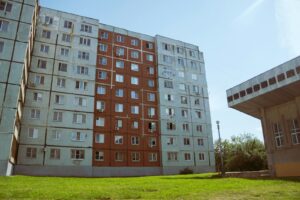By Emily Smith, COO, Argyll, and Sarah Halpin, Head of Sustainable Solutions, Ramboll
With 25% of UK emissions directly attributable to the built environment, it is essential that delivering on sustainability targets remains at the forefront of the built environment agenda. The role of UK office stock in contributing to these emissions cannot be ignored, particularly with 87% of this stock rated at an EPC rating of ‘C’ or lower according to Savills research.
Clearly, office providers and landlords need to double down on their efforts to meet rapidly approaching sustainability targets. Amid the rush to achieve net zero emissions, newer construction projects are often seen as a sure-fire way to bring EPC ratings down, but existing and heritage buildings demand similar attention and can offer untapped potential for contributing to a sustainable office stock through effective retrofit strategies.
Solely concentrating on new developments adhering to sustainable standards will not be sufficient for the transition to net zero and should not be regarded as a panacea to sustainability issues. In fact, approximately 35% of the lifetime carbon emissions from a typical office development has already been released prior to official opening, according to the Royal Institute of Chartered Surveyors (RICS).
The tendency to laud new builds for their sustainable offering comes further into question when considering that around 80% of the buildings we anticipate will exist in 2050 are already standing. So, why are we continuing to neglect retrofitting efforts?
Retrofitting should take centre stage as a crucial solution, not only for revitalising existing office buildings and adapting to the evolving needs of the modern workforce, but also for spearheading sustainability efforts. Argyll, for example, has undertaken an ambitious refurbishment project across its office building portfolio, to upgrade a number of its heritage buildings in line with the needs of the modern workforce, whilst effectively driving down EPC ratings and capping emissions at every opportunity.
Only by adopting a data-led approach, addressing existing policy gaps hindering retrofit efforts, and recognising the core value of existing and heritage buildings can we shift focus from new builds being deemed the only sustainable solution and towards retrofitting our existing stock. Whilst heritage buildings face a unique set of challenges in their retrofit ambitions, due to the legislation and protections in place to preserve historic aspects, this does not undermine their role in decarbonising efforts – which must be considered in tandem with existing stock to move the dial on UK retrofit.
The data revolution
Businesses are rapidly embracing a data-driven approach, with continuously evolving technologies and tools at the centre of this. For retrofitting efforts, the importance of data for gathering invaluable insights across a broad spectrum of activities is palpable, from the construction materials and their transportation through to the overarching evaluation of design considerations. Such data-driven insights fuel the optimisation of retrofitting strategies.
One such technology designed to maximise the data and information we can collect at every stage of the design and construction process is digital carbon modelling, which captures high-precision data on the environmental impact of several construction material aspects, from the raw materials themselves to manufacturing, routes and methods of transportation.
Ramboll, for example, has created a tool that parametrically analyses decarbonisation pathways at an asset or portfolio scale. This empowers property managers to identify the most efficient strategies to decarbonise entire estates in light of the resources available to them and their specific goals.
The seamless integration of such technologies can increase the success of retrofitting outcomes by informing project decision-making, as architects can feel empowered that their decisions are based on comprehensive and accurate data-led insights. Stakeholders can, therefore, leverage such technology to drive strategies aligning with their sustainability objectives and offer meaningful and quantifiable metrics of success.
A further innovative technique involves utilising digital twin technology to create virtual replicas of existing buildings within a digital simulation. A broad range of performance metrics are captured by sensors, including energy outputs, enabling project leaders to pinpoint potential energy leaks and weak points. By revealing areas of inefficiency, project leaders can use these metrics to create tangible solutions in the real world, improving the energy efficiency of buildings.
In the case of digital twin technology, stakeholders see a convergence of the real world and digital environments, as real-world data seamlessly interfaces with the digital twin, establishing a continuous two-way flow of collected and stored data between the environment and system processor. This offers invaluable insights, which ultimately enable rapid and customised building optimisation to enhance project outcomes.
Policy issues
While the advantages of retrofitting existing and heritage buildings are plenty, there is a lack of alignment with planning regulations that ultimately hinder its efficacy. Retrofitting faces substantial hurdles at a governmental and policy level, including an absence of clear policies to inform planning frameworks. This has left businesses grappling with ambiguous industry standards and a lack of best practice guidelines.
The Building Consent Regime has presented a potential route to regulate planning permissions, but unfortunately this has been limited in its ability to bolster projects on a local level. While the framework is theoretically fit for purpose, local authorities frequently lack the specialised expertise needed for its efficient execution, resulting in disparities in implementation throughout the UK.
Additionally, the government continues to favour new construction, posing a significant threat to retrofitting initiatives. The perception that new construction projects are better than retrofitting for sustainability efforts, coupled with the economic incentives linked to constructing new buildings, such as VAT exemptions, mean that more often than not, retrofitting existing stock is left ignored.
Prioritising the development of successful retrofitting strategies should be the top priority for both government and businesses and offering financial incentives is an obvious first step. However, creating a well-defined planning framework, supported by comprehensive guidance documents outlining best practices, also has significant potential to drive change.
Working with heritage
Whilst data-led initiatives and policy-wide change are critical, smaller scale retrofitting interventions complimenting the existing structure of a building can also significantly improve a building’s emissions. Smaller scale interventions to improve a building’s energy consumption and usage are particularly valuable when retrofitting heritage buildings, which are often more limited by legislation and protections to preserve a building’s historic value.
For example, implementing LED lighting systems that imitate traditional fixtures and incorporating natural ventilation methods to reduce dependence on mechanical heating and cooling systems, along with upgrading to energy-efficient heating and cooling systems, can notably enhance EPC ratings. This is illustrated by 84 Brook Street, one of Argyll’s heritage properties, which saw its EPC rating improve from ‘D’ to ‘B’ under the guidance of heritage and sustainability experts and undertaking the above interventions.
Retrofitting can provide a solution to structural and amenity challenges, in some cases enabling heritage buildings that were constructed with techniques and materials that fall short of modern safety and structural standards to be structurally fortified while simultaneously accommodating modern technological needs. Enhanced discreet insulation, HVAC systems, and accessibility features, for example, allow these heritage buildings to become functional for workforces.
Naturally, retrofit strategies have to be deployed carefully to preserve and protect heritage and listed aspects of older buildings, and delicately work with the heritage fabric of a building to ensure that historical and cultural value is maintained in the face of ambitious ESG objectives.
Looking ahead
Retrofit holds the potential to transform the future of office spaces for the modern workforce and advance progress on net zero objectives. Landlords, consultants, architects and engineers can harness the power of data and cutting-edge technologies to enhance the energy efficiency of existing, and heritage, structures, ranging from scrutinising individual material transportation routes and processes to large-scale comprehensive building modelling. Now we need transparency of industry standards coupled with clearcut policy to create the optimal conditions for retrofit to thrive and fulfil its potential to transform our built environment.
Images: Glenn Carstens-Peters and CHUTTERSNAP
More features:
The role of landlords in meeting ESG objectives for the serviced office sector
Distinguishing between race equality and race equity in the UK housing sector

















Leave a Reply